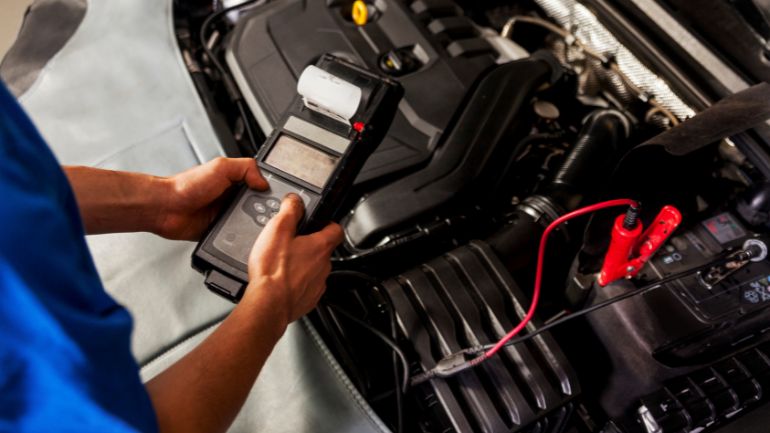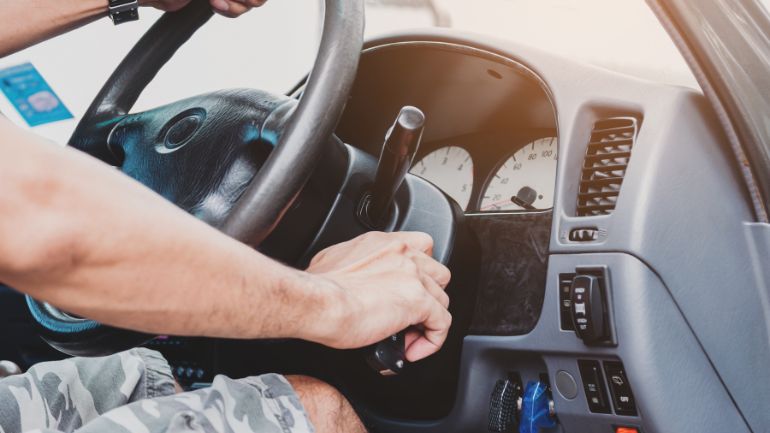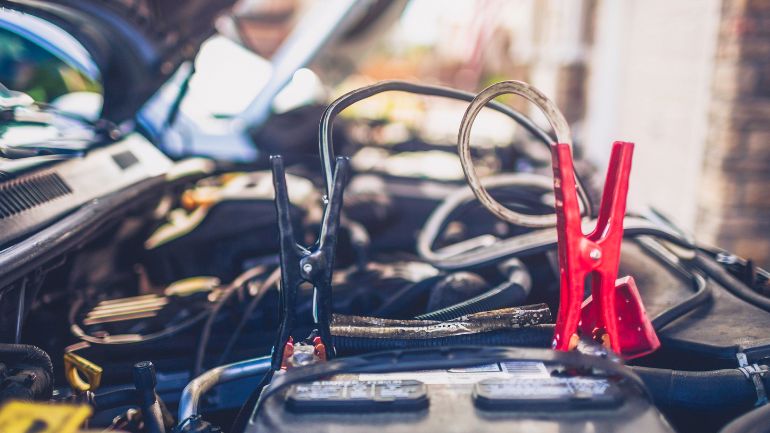Car problems can happen in the blink of an eye so it is essential to be ready for anything. With so many moving components, it can be difficult to know what exactly has gone wrong. If your car is beeping and won’t start, the battery likely has a bad cell, or it has been discharged.
It is possible to have the battery load tested at most automotive stores. Alternatively, a mechanic can help diagnose and fix the problem. I’ve encountered such problems numerous times, so I know a thing or two about dealing with this issue.
In this comprehensive guide, I will provide a rundown of the reason why your vehicle is beeping and not starting, as well as possible fixes.
Table of Contents
Why Is My Car Beeping And Won’t Start? Most Common Causes
When an automobile won’t start, there could be several problems at play. Some are easier to identify than others. For instance, you may have forgotten to turn off your lights, causing your battery to drain during the night.
This can be rectified easily by jump-starting the battery. It can be harder to pinpoint issues with the starter or alternator. When in doubt, it is always best to get help from a professional mechanic.
The Battery Was Drained

The most common reason vehicles won’t start is a dead battery. Over time, batteries are going to wear out and lose their ability to hold a charge. As a result, the battery may need to be replaced.
However, there is a possibility that the battery was drained because you left the lights or radio on all night. I always recommend using a battery tender when the vehicle is not going to be driven for a while.
Otherwise, the battery may drain as well. After all, vehicle batteries are charged by the alternator when the vehicle is on.
If the vehicle hasn’t run for a while, the alternator won’t charge the battery, and it may need to be jump-started. Regardless, the vehicle won’t start, and the electrical components won’t work until the battery is charged or replaced.
Even if you hear a beeping noise, you may have a dead battery. Use an alternate vehicle to jump-start the car in question. If the vehicle starts, I would drive it for a while before turning it back off.
If you’re unable to jumpstart the vehicle, you will need to replace the battery.
Starter Problems
Although it is hard to know the exact cause without physically inspecting the automobile, there is a good chance the starter is the source of the problem.
The starter is responsible for getting the motor to turn on and operate as normal. Once the motor is running properly, the starter’s duty has been fulfilled. Even if you have a fully charged battery, a faulty starter will prevent the vehicle from turning on.
I would listen carefully when I am trying to start the automobile. If I hear a faint clicking noise, I know that the problem is likely the starter. It is also possible to detect impending starter problems by paying close attention to your vehicle.
If you’re having random problems starting your vehicle or you’ve noticed smoke coming from the hood, the starter could be bad. Be sure to listen for grinding, whirring, and clinking noises because they can tell you that a starter is about to malfunction.
If your starter malfunctions, you’ll need to have it replaced.
Don’t Forget The Alternator
Although it isn’t likely, your vehicle’s alternator could be the primary problem. Faulty alternators account for roughly 2% of similar situations. However, it may not be the actual alternator.
Instead, the alternator drive belt may have broken due to wear. Alternatively, the issue could be the wiring. The alternator is vital because it delivers electricity for the radio, lights, and heating.
More importantly, the alternator charges the battery when the vehicle is being used. I can pinpoint certain sounds and smells to determine when an alternator is going back.
For instance, a bad alternator will cause difficulty starting the vehicle, regular stalling, and a screeching noise after the vehicle starts. The vehicle’s lights may be too dim or too bright.
Check the warning lights on the dashboard. If the battery light is on, your alternator may be on its last legs. A mechanic can help determine whether the alternator should be replaced or whether you’re just dealing with a bad belt.
Bad Ignition Switch

The ignition switch can stop the vehicle from starting properly. The switch delivers voltage to the starter motor to ensure that the engine can crank over and start. Unfortunately, ignition switches do not last forever so they must be replaced from time to time.
Thankfully, you can identify a problematic ignition switch easily. Place the key in the ignition and turn it over without starting the automobile.
This should turn on the lights, radio, and dashboard. If these things turn on, the battery is still working. The problem is likely the ignition switch.
A bad ignition switch will also make it difficult for the engine to continue running. It might be tough to turn the key too. Depending on the source of the issue, it may be essential to replace the ignition switch.
A dealership can rebuild the switch so you can continue using your old keys. Otherwise, you’ll need to replace the switch and change the keys.
Intake Problems
The vehicle’s intake is important because it helps add oxygen to the combustion chamber in the engine. If something goes wrong with the intake, the chamber may receive too much or too little oxygen. Having an incorrect mixture of air and fuel can impact the performance of the engine and lead to other serious issues.
It could also hinder the cooling system for the engine. A motor intake issue may be the reason you’ve been unable to start your vehicle. Have you noticed any sputtering in the last few weeks or months?
If so, this is likely the cause of the problem. Changing an intake is a lengthy process, although it is possible to do it without a professional.
When something is wrong with the intake, you’ll experience poor engine performance. The vehicle may lose power, you may encounter misfiring, and the vehicle may accelerate roughly.
Furthermore, the car may beep without starting.
Fuel Problems
While it may seem unlikely, the cause of the problem could be a lack of fuel. Since you live a busy lifestyle, there is always a chance that you’re going to forget to refuel your vehicle. It has happened to me previously, and I know I am not the only one.
Check the fuel gauge and make sure you have enough fuel in the tank to start the car. Thankfully, this is an easy fix since you only need to add more gas to the tank.
If you run out of gas on the roadway, try to pull the vehicle to the shoulder. Then, you can call a friend to bring you gas. If the fuel level isn’t the problem, it may have something to do with the fuel filter.
An obstructed filter could prevent the vehicle from starting even when it is beeping. Since the filter is clogged, the fuel is unable to reach the motor.
As a result, the vehicle won’t start. To avoid this problem, it is recommended that you change your fuel filter at least every 20,000 miles.
A clogged filter could prevent the vehicle from starting and cause engine misfires.
Issues With The Motor
In some cases, the vehicle won’t start because there is a problem with the motor. In general, the problem was likely caused by the crankshaft or the timing chain.
When this is the problem, the motor either won’t start or it’ll end up stalling.
Car Beeping With A Dead Battery
If you’re dealing with this problem, your battery might be dead. You may expect that a dead battery will stop everything.
However, this may not be the case. Even with a dead battery, your vehicle may beep. Certain vehicle components have rechargeable batteries that will remain charged even when the main battery is drained.
In particular, it is common for alarm systems to have separate rechargeable batteries that could cause the vehicle to beep. Even though you’re hearing a beep, you may still need to jump or replace your battery.
Jumping Your Battery

I can tell you from experience that jumping a battery is simple and safe. Still, it is a good idea to check your vehicle’s manual to ensure that you’re following the correct steps. You’ll also want to check the manual of the alternate vehicle since the process may differ slightly.
Before trying to start the vehicle, check the battery’s cables and connections. You may notice that one of the connections is loose. Tighten it and try starting the car again.
Also, look at the cables to ensure they’re still in good condition. In some cases, battery cables can become worn and burned to the point that they’re no longer working correctly.
If everything is okay, you can go ahead and try jumping the battery. Call a friend who will let you use their vehicle for this purpose, or use your second car.
Park the second vehicle close to the other one. Open the hoods and grab the jumper cables. The red clamp should be attached to the position battery terminal.
Start by hooking the red clamp to the dead battery before connecting it to the good battery. Then, you can do the same with the negative terminals. Start the secondary vehicle and leave it running.
Try starting the vehicle with the dead battery. If it starts, remove the cables in the opposite order. Be sure to leave the vehicle running so the alternator can recharge the battery.
Properly Maintaining A Car Battery
Nobody wants to get stuck on the road because their vehicle has broken down. Although it is impossible to avoid all problems, steps can be taken to preserve the battery.
In particular, the vehicle’s battery should be properly maintained to avoid breaking down. For instance, it is wise to clean the battery terminals a few times each year. Use water, baking soda, and a toothbrush.
Terminal spray can be applied to the terminals to prevent corrosion. It is also pertinent to check the bolts and connections. The vibration from the vehicle will cause these bolts to loosen, so be sure to tighten them regularly.
In extremely cold environments, a battery heater can protect the battery from damage. While this isn’t necessary in all areas, it is a good idea in cities that experience frigid temperatures.
Be sure to check the fluid level often. Remove the vent caps and use a flashlight to look inside each cell. The fluid should completely cover the plates.
When necessary, add more distilled water. When you need to replace your old battery, buy a new one.
Check the manufactured date and buy one that is less than a month old for the best results.
FAQs
How Long Will My Car Battery Last?
Some people will be lucky enough to use the same car battery for up to six years. However, most car batteries will be replaced within three to four years. If something is wrong with the battery or another problem occurs, the battery may need to be replaced even sooner.
When Should A Car’s Battery Be Replaced?
It is difficult to know exactly when a vehicle’s battery should be replaced because each situation is different. Batteries used in extreme temperatures will likely need to be replaced sooner. To avoid being stranded, ask your mechanic to inspect the battery each time the oil is changed.
Why Does My Car Beep When I’m Driving?
When a vehicle is being driven, it may beep unexpectedly. Usually, this is a warning sign that something is wrong with the electrical system. You may be dealing with a blown fuse, damaged wires, or something similar.
Get the car inspected to find out what is wrong.

Robert Bacon is a car nerd and automotive lover who has dedicated his life to understanding the inner workings of vehicles. He holds a degree in mechanical engineering and has spent years working as a mechanic and engineer for some of the world’s top car companies. In his spare time, he enjoys writing about cars on this blog and tinkering with his 2016 Toyota Mirai in his garage.
My fuso truck won’t start and keeps beeping